Pulse on Policy: Assessing and Addressing Emerging Risks Facing Greater San Diego’s Nonprofits
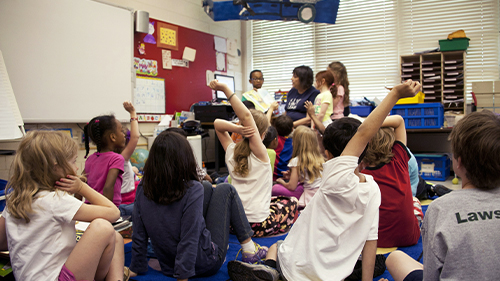
Alan Berube, Senior Vice President
The first 100 days of the second Trump administration have challenged leaders in all sectors of the U.S. economy. Dozens of government agencies and programs at the federal level have seen their funding terminated, and counterparts at the state and local levels have encountered federal funding suspensions and recissions. Businesses are navigating chaotic changes to U.S. trade policy, stressing supply chains and imperiling small businesses in particular. Higher education institutions are attempting to weather ideologically-motivated threats of federal funding withdrawal, and many of their international students have had their visas revoked for similar reasons.
Amid these far-reaching dynamics, local nonprofits have also found themselves buffeted by early Trump administration actions. These include executive orders aimed at eradicating efforts focused on increasing ethnic and racial diversity/inclusion, combating climate change, and assisting recent immigrants; terminations of agencies (e.g., USAID, Institute of Museum and Library Sciences) that relied on NGOs to carry out their missions; blanket funding freezes that stressed small nonprofit budgets; and changes in federal reimbursement policies that jeopardize the financial viability of nonprofit research organizations. Beyond those immediate challenges, budget proposals from the Trump administration and Congressional Republicans threaten severe cuts to supports for low-income individuals and families—in areas such as health, affordable housing, childcare, and nutrition—for which nonprofit organizations serve as critical intermediaries.
Building on last month’s Pulse on Policy, which examined the importance of federal spending to Greater San Diego, this month’s edition takes a closer look at the region’s nonprofit sector (excluding higher education). It profiles the sector overall and its reliance on government funding, the risks its different segments may face from emerging federal pressures, and the ways in which local leaders can respond.
San Diego County has a vast nonprofit sector that receives significant support from government
The most recent Internal Revenue Service (IRS) data reflect more than 13,000 nonprofits registered in San Diego County. The largest numbers of these organizations focus in the areas of education and youth (e.g., charter schools, Boys & Girls Clubs); religiously-affiliated services (e.g., churches, missions); and support for families and workers (e.g., employment and training organizations, childcare centers). Based on the most recent tax filings available for the region’s nonprofits, the bulk of nonprofit revenue from all sources (nearly $32 billion overall) went to health-focused organizations: principally, nonprofit hospitals and health plans, and community health clinics.
Government—federal, state, and local combined—provides support to all of San Diego County’s nonprofit sub-sectors, but in differing degrees. Among 10 sub-sectors identified for this analysis, arts and culture organizations were the most likely (43%) to receive government contributions in 2023, followed by those focused on the environment (34%), science (31%), and housing and neighborhoods (24%). Reliance on government dollars also varies by nonprofit location within San Diego County. Nonprofits located in Central San Diego (31%) and South Bay (20%) are more likely to receive government contributions than nonprofits located in somewhat more affluent parts of the county to the north and east.
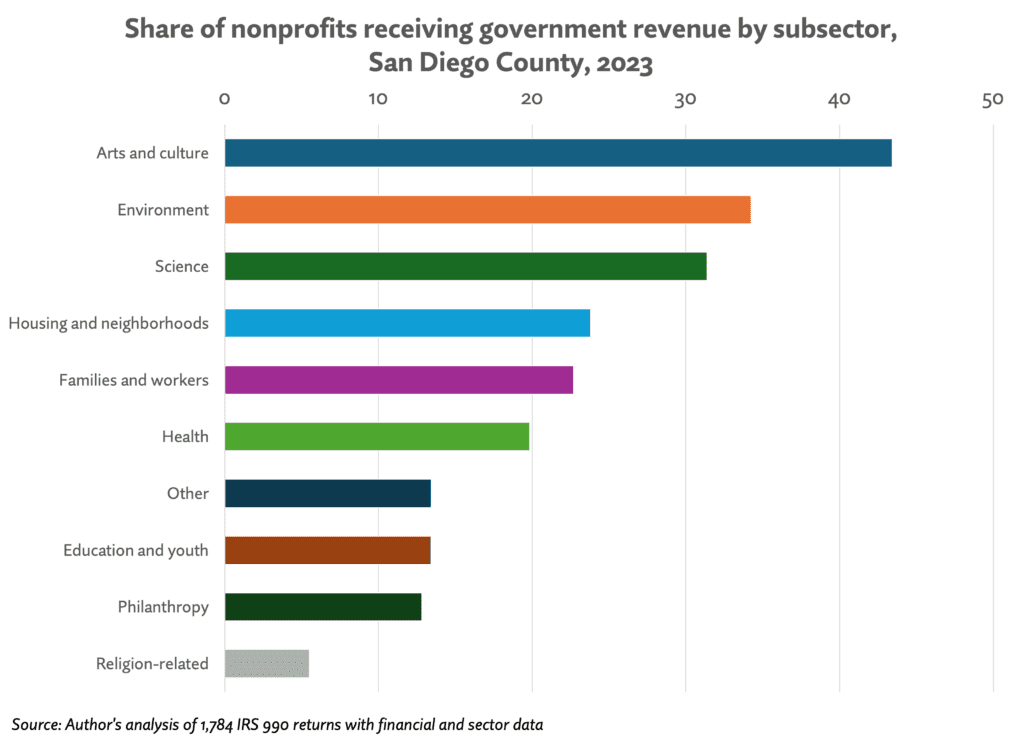
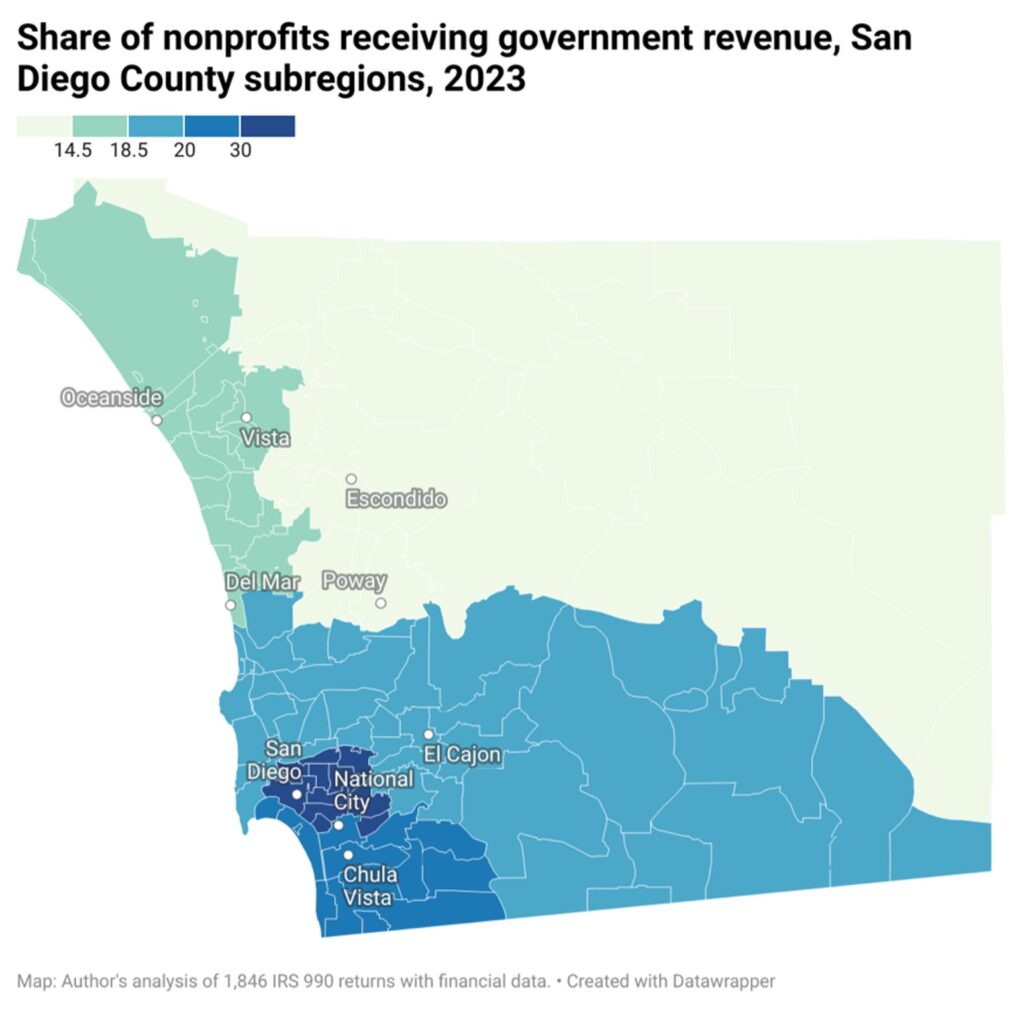
Those government dollars, in turn, have differing impacts on organizational bottom lines by sector. Borrowing an approach from a recent Urban Institute study, I examined how likely organizations were to run a surplus (greater revenues than expenses) in 2023, with and without government revenues. Among nonprofits that received government funding, those focused on families and workers, housing and neighborhoods, and education and youth depended most heavily on government dollars to maintain operating surpluses. In each of those sub-sectors, the share of San Diego County nonprofits that would have incurred a deficit absent their government contributions exceeded 40%. In this way, organizations that focus on economically marginalized individuals, families, and communities could find themselves at greatest financial risk from sudden changes in government funding eligibility/availability.
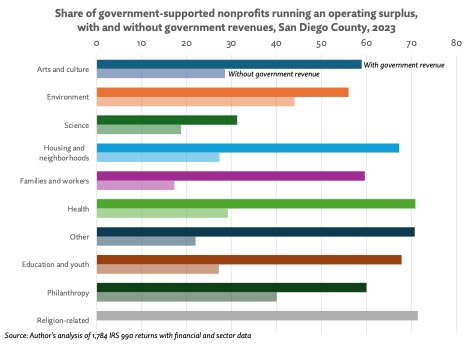
Direct federal grants/contracts to San Diego County nonprofits are less widespread, but important to a few key sub-sectors and organizations
While financial filings suggest that perhaps 20% of all Greater San Diego nonprofits receive government contributions, federal grants and contracts reach a smaller number of local nonprofits. Data for the latest fiscal year identifies 126 local nonprofits receiving federal support through a grant, subgrant, or contract, totaling $674 million. To be clear, these totals do not include nonprofits that received reimbursements for federally supported programs (e.g., Medi-Cal) or other forms of direct federal support such as tax credits (e.g., to subsidize provision of low-income housing or clean energy).
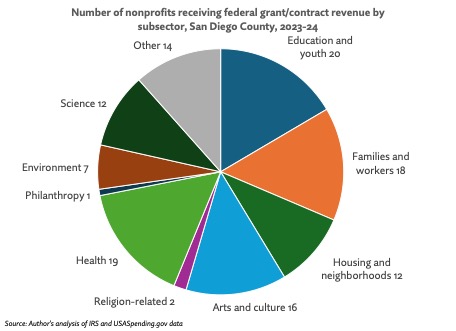
The single largest nonprofit recipient of federal support in San Diego County is Scripps Research Institute. It received $156 million in federal grant and contract revenues in the most recent fiscal year, the vast majority from the National Institutes of Health (NIH), to support a wide range of cutting-edge research on disease prevention and treatment. Those awards accounted for a little under 20% of Scripps’ total revenue that year.
For other nonprofit organizations and sub-sectors, total federal support is smaller in absolute terms, but may be even more important in budgetary terms. For instance, the analysis identifies more than 20 local organizations working in areas such as affordable housing, childcare, worker support, and criminal justice for which federal grants and contracts account for more than half their total revenue. These nonprofits are likely already on high alert. For example, Neighborhood House Association and Metropolitan Area Advisory Committee, two local Head Start providers, are sounding the alarm about how the Trump administration’s proposal to end the program would negatively impact local working parents and their children.
Beyond immediate sources of financial uncertainty, the Trump administration is also proposing deep spending cuts for the federal agencies on which many San Diego-area nonprofits depend. According to the Washington Post, the administration is seeking to slash discretionary spending at the Department of Health and Human Services (HHS) by roughly one-third. This would affect major grantor agencies for the region’s nonprofits, including NIH ($293 million), the Administration for Children and Families (ACF, $98 million), the Health Resources and Services Administration (HRSA, $32 million), and the Substance Abuse and Mental Health Services Administration (SAMHSA, $7 million). The Veteran’s Health Administration, which provided local nonprofits with nearly $11 million last year, also faces budgetary pressure from the administration. Congress must still weigh in on these proposals, but the budget framework the House GOP recently adopted could pave the way for severe spending reductions such as these.
Local nonprofits must organize on multiple fronts
Mature, mission-oriented nonprofit organizations know how to navigate lean times brought on by economic and market downturns. As available resources decline, seasoned nonprofits typically refocus on core programs and operations; adopt strategic cost control measures; and merge or share services with other organizations to achieve more with less.
The scale and nature of the challenges this time, however, may be quite different. Some nonprofit organizations could face a “triple whammy”: an economic recession, brought on by trade wars and other chaotic federal policies, that ratchets up community needs while shrinking available resources; a significant federal budgetary retreat from major areas of nonprofit service provision; and frontal assaults by the executive branch on nonprofit missions, exemplified by efforts to revoke their charitable statuses and/or terminate funding eligibility altogether.
In the face of these converging challenges, leaders in the San Diego region should consider pursuing a few common approaches to safeguard the health and impact of the nonprofit sector:
- Maintain vigilance. As policy and budget actions continue to evolve swiftly in Washington, organizations such as the National Council of Nonprofits provide valuable updates on the state of play and their implications for nonprofits of all kinds. At the local level, the University of San Diego’s Nonprofit Institute “pulse” survey of nonprofit leaders has provided timely insights on challenges the sector faces and possible responses, with helpful detail by nonprofit focus area and size.
- Practice triage. Philanthropy can provide different types of support to nonprofit organizations depending on the nature and severity of their challenges. At the broadest level, philanthropy can convene nonprofits within and across sectors to facilitate the sharing of programmatic, financial, and legal best practices, and to build common knowledge and cause. For nonprofits facing short-term financial strains due to delayed reimbursements, philanthropy can provide enhanced working capital. And for nonprofits that rely primarily or exclusively on cancelled federal programs, such as those that support refugees and asylees, or work with AmeriCorps volunteers, philanthropy can assist them in pivoting into related service areas, or merging/pausing/winding down their operations compassionately.
- Prepare for the future. While local leaders should work together in efforts to fend off the worst-case near-term federal policy scenarios, they should also prepare themselves for the likelihood of at least some permanent change. Along those lines, San Diego County and other governments throughout the region are wise to consider how they might marshal greater local resources to address local needs, leveraging a strong and capable local nonprofit sector. Business and philanthropy can partner with government to evaluate financing options and build the case for new approaches.
Americans’ devotion to civil society is a longstanding attribute of our republic, as Alexis de Tocqueville observed nearly 200 years ago in Democracy in America. In San Diego County and elsewhere, the sector may look different on the other side of the current crisis, but local leaders should act with the knowledge that nonprofits’ work will remain essential to our national identity and purpose.